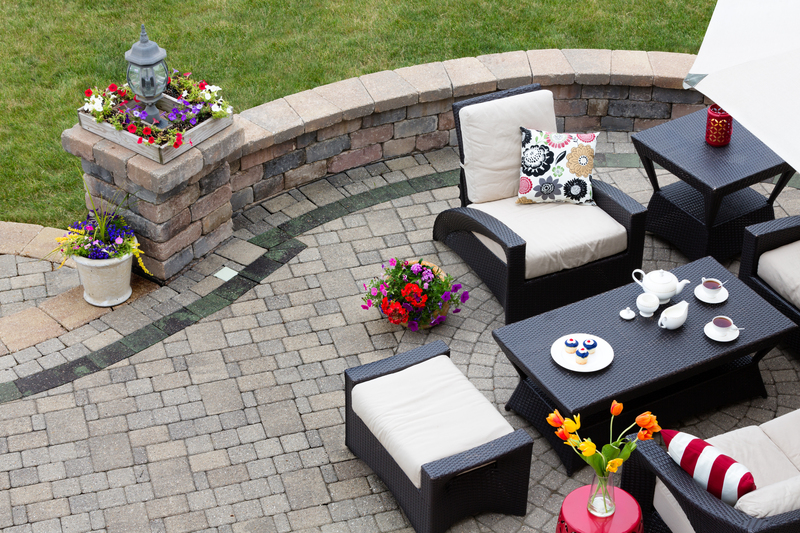Vertical Gardening: Harmony in Small Spaces
Posted on 21/09/2025
Introduction to Vertical Gardening: Embracing Harmony in Compact Spaces
In today's urbanized world, the desire for lush green spaces often clashes with limited living areas. Enter vertical gardening--a creative and innovative solution that allows city dwellers and homeowners to cultivate vibrant gardens, even within the constraints of small balconies, apartments, or narrow patios. As the popularity of vertical gardens and green walls continues to rise, more people are discovering how these upward-growing sanctuaries can bring nature, tranquility, and functionality into their lives. This comprehensive guide explores the philosophy, benefits, and practicalities of vertical gardening, showing you how to achieve harmony in your small spaces.

What is Vertical Gardening?
Vertical gardening is the practice of growing plants upwards using structures such as trellises, shelves, wall-mounted containers, or living walls, instead of the traditional horizontal soil beds. This ingenious method maximizes vertical space and transforms tiny spaces--from balconies and patios to interior walls--into lush green habitats. By moving your garden skyward, you unlock the potential for beauty, productivity, and environmental benefits, even in the most limited settings.
Key Features of Vertical Gardens
- Space Efficiency: Utilizes underused wall and vertical surfaces, making it ideal for small or urban homes.
- Aesthetic Appeal: Instantly adds visual interest and texture to dull walls and fences.
- Environmental Enhancement: Contributes to better air quality and a cooler microclimate.
- Productivity: Allows for growing herbs, veggies, and ornamental plants in minimal spaces.
Why Choose Vertical Gardens for Small Spaces?
The quest for harmony in small spaces often leads homeowners to creative solutions. Vertical gardening stands out for its ability to integrate greenery into environments where horizontal gardening is simply not possible. Here are compelling reasons to adopt vertical gardening techniques in your home or apartment:
- Optimization of Space: Urban apartments and small patios rarely have excess ground space. Vertical systems utilize wall areas, freeing up valuable floor space for other uses.
- Improved Air Quality: Plants filter volatile organic compounds and dust, keeping interiors fresher and healthier--a crucial benefit in city living.
- Reduced Urban Heat: Green walls and vertical planters naturally cool living spaces through shading and evapotranspiration.
- Increased Biodiversity: Even a modest vertical garden can attract pollinators, increase beneficial insects, and boost local nature.
The Principles of Harmony in Vertical Gardening
Creating a harmonious vertical garden goes beyond simply stacking pots. It involves aligning plant selection, design, and maintenance with the natural rhythms of your living space. Consider these principles:
Balance of Elements
- Light: Evaluate sunlight patterns to ensure every plant gets adequate light.
- Water: Opt for irrigation systems that evenly distribute water along your vertical surface to prevent dry or oversaturated areas.
- Color and Texture: Vary leaf shapes and flower colors to create visual balance and interest.
Integration with Living Spaces
Harmony is achieved when your vertical garden seamlessly blends with your home decor and daily life. For instance, a kitchen wall garden bursting with fresh herbs not only beautifies the space but also adds culinary convenience. Integrating the garden location, selecting containers that complement your furniture, and incorporating purpose--such as privacy or shade--help establish harmony.
Types of Vertical Gardens for Small Spaces
There are numerous creative approaches to vertical gardening, each suitable for a variety of tastes and settings. Here are some popular types:
- Living Walls: These are large-scale or modular systems where plants grow in panels affixed to walls. Living walls often include automatic irrigation and can turn entire walls into lush, oxygen-producing artworks.
- Vertical Planters: Stacked pots, hanging containers, or multi-tiered shelves are budget-friendly and adaptable for balconies and compact patios.
- Pallet Gardens: Used pallets can be repurposed as growing structures for herbs, succulents, or flowers--perfect for eco-conscious gardeners.
- Trellises & Climbers: Maximizing verticality by training vining vegetables and flowers (like beans, peas, or clematis) to climb trellises or wireframes.
- Pocket Planters: Felt or canvas pockets mounted on walls provide individual planting spots for a vibrant, textural effect.
Choosing the Right Plants for Your Vertical Garden
Selecting the right plants is crucial for the success and harmony of your vertical garden. Some plants naturally adapt to upright growth, limited soil, and varying moisture levels better than others. Consider the following:
Best Edible Plants for Vertical Gardening
- Herbs: Basil, thyme, oregano, mint, parsley, and chives thrive in small containers and grow quickly.
- Leafy Greens: Lettuce, spinach, arugula, and kale can be harvested continuously and require limited root space.
- Strawberries: These can hang beautifully and yield delicious fruit.
- Dwarf Tomatoes & Peppers: Choose compact, bush varieties suitable for containers.
Ornamental Plants for Vertical Gardens
- Ferns: Add texture and thrive in humid, shady spots.
- Succulents: Low-maintenance and perfect for sunny, dry locations.
- Orchids & Bromeliads: Exotic and striking for interior green walls.
- Ivy & Vines: Provide a lush, cascading effect for dramatic harmony.
How to Set Up a Vertical Garden: Step-by-Step Guide
Building a harmonious vertical garden system involves a blend of creativity, planning, and careful execution. Here's how you can design and install a vertical garden at home:
1. Evaluate Your Space
- Choose a wall or fence that receives the appropriate amount of sunlight for your chosen plants.
- Ensure the surface is strong enough to support the weight of your planters and plants, especially when watered.
2. Select Your Structure or System
- Decide between DIY options (such as pallets, hanging pots, or shelves) and ready-made vertical wall systems.
- Waterproof backing can protect your walls if gardening indoors.
3. Choose Soil and Irrigation
- Use a lightweight, high-quality potting mix with adequate drainage and nutrients for healthy root growth.
- Consider drip irrigation or self-watering planters for easy, consistent watering.
4. Select and Arrange Your Plants
- Mix plants with similar water and light needs in each section of your garden.
- Layer trailing plants at the top and bushier varieties below for a cascading effect and efficient water use.
5. Install and Plant
- Secure your structure to the wall or fence according to safety guidelines.
- Plant each container or pocket, ensuring roots are well-covered and soil is firm.
- Apply mulch to retain moisture and reduce evaporation.
6. Maintain Your Vertical Oasis
- Monitor for pests or diseases and prune regularly to encourage healthy growth.
- Feed plants periodically with organic fertilizer to keep them lush and vigorous.
- Check irrigation systems and soil moisture, adjusting as needed based on seasonal changes.
Inspiring Ideas for Vertical Gardens in Small Spaces
Looking for design inspiration to achieve perfect harmony in your small space? Try these creative vertical garden ideas:
- Repurposed Shoe Organizers: Hang cloth shoe organizers filled with herbs or salad greens on a sunny wall.
- Mason Jar Wall Planters: Attach jars to wooden boards or fence posts, ideal for small kitchen plants.
- Leaning Ladder Gardens: Place pots or trays on each rung of an old ladder for a rustic display.
- Tin Can or Bottle Gardens: Upcycle containers for eco-friendly, compact plant displays.
- Indoor Green Walls: Use modular felt or plastic pocket systems on a living room or bathroom wall for year-round freshness.
Addressing Challenges and Ensuring Success
While vertical gardening offers numerous advantages, it comes with a few challenges. Recognizing and addressing these ensures your green wall or vertical planters thrive for years to come.
- Water Management: Vertical gardens dry out faster than ground beds. A reliable watering routine or automated drip system is essential.
- Plant Stability: Secure heavy planters and ensure roots have enough substrate to prevent toppling or wind damage.
- Soil Fertility: Limited soil volume means plants exhaust nutrients quickly. Regular feeding and occasional soil replenishment can keep your garden lush.
- Pest Control: Crowded plants can be prone to mildew or insects. Encourage air circulation and inspect often.
The Environmental Impact of Vertical Gardens
Aside from aesthetic and personal benefits, vertical gardens contribute significantly to urban sustainability and environmental health. Here's how:
- Reduces Urban Heat Island Effect: Green walls insulate buildings, lower energy usage, and cool the surrounding environment.
- Improves Air Quality: Foliage absorbs pollutants, dust, and carbon dioxide, while producing healthy oxygen.
- Fosters Urban Agriculture: Enables the local cultivation of food, reducing transportation emissions and fostering food security.
- Encourages Biodiversity: Even a simple vertical herb garden can attract bees, butterflies, and beneficial insects.

Vertical Gardening Trends: The Future of Green Living
As more people embrace vertical gardens and other space-saving gardening methods, city landscapes are becoming greener, healthier, and more visually stunning. Innovations such as hydroponic walls, smart irrigation systems, and modular eco-panels allow even beginner gardeners to tap into this harmonious blend of nature and modern living.
- Smart Green Walls: Tech-integrated systems monitor and adjust watering, lighting, and nutrient delivery for optimal plant health.
- Modular Kits: Pre-designed panels make installation quick and flexible for renters and homeowners alike.
- Edible Art: Combining vegetables, herbs, and flowers for functional and beautiful wall decor.
- Indoor Wellness Gardens: Focusing on air-purifying plants to enhance health and relaxation in homes and offices.
Conclusion: Cultivating Harmony with Vertical Gardening
By integrating vertical gardening solutions into small living spaces, anyone can experience the joy of gardening, foster a connection with nature, and achieve genuine harmony between beauty and utility. Whether you're looking to grow fresh herbs for the kitchen, create a soothing green retreat, or simply add vibrancy to an empty wall, the possibilities are endless. Start small, experiment with designs and plant choices, and watch your vertical space come alive--proving that even the tiniest home can host a breathtaking garden sanctuary.
Vertical gardening: the ultimate expression of harmony in small spaces. Embrace the upward green revolution today!

